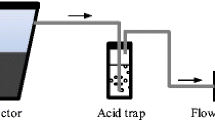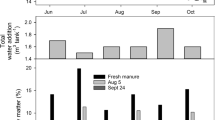Abstract
The influence of temperature and storage time on hydrogen sulphide (H2S) emissions from two different dairy manures was investigated over four seasons in 2012. Two separate experiments were conducted using dairy manure; (1) water baths at 0, 5, 10, 15, 20, 25 and 30 °C that were incubated for 15 h, and (2) 28-day batch experiment under room temperature. The headspace H2S concentration increased exponentially after 15 °C and reached a maximum of 3.1 mg/L at 30 °C. After the 4th day of storage, dairy manure emitted an average of 3.6 mg/L of H2S. However, a small decrease was observed on the 28th day, with a concentration of 2.8 mg/L. Under natural conditions, dairy manure emitted significantly lower H2S values during winter than during spring, summer and autumn when manure is widely used as fertiliser. Furthermore, regardless of the incubation temperature and storage time, manure from cows fed with concentrate-based feed emitted much higher H2S (6.5 times) than from cows fed with forage-based feed. These results indicated that the emissions of H2S from dairy manure could be managed by feeding cows minimal concentrate feed and by handling manure at cooler temperatures or lengthening the retention time.








Similar content being viewed by others
References
Wing S, Wolf S (2000) Intensive livestock operations, health, and quality of life among Eastern North Carolina Residents. Environ Health Perspect 108(3):233–238
Trabue S, Scoggin K, McConnell L, Maghirang R, Razote E, Hatfield J (2011) Identifying and tracking key odorants from cattle feedlots. Atmos Environ 45:4243–4251
Hobbs PJ, Misselbrook TH, Cumby TR (1999) Production and emission of odorous and gases from ageing pig waste. J Agric Eng Res 72:291–298
Blanes-Vidal V, Hansen MN, Adamsen APS, Feilberg A, Petersen SO, Jensen BB (2009) Characterization of odor released during handling of swine slurry: part II. Effect of production type, storage and physicochemical characteristics of the slurry. Atmos Environ 43(18):3006–3014
Campagna D, Kathman SJ, Pierson R, Inserra SG, Phifer BL, Middleton DC, Zarus GM, White MC (2004) Ambient hydrogen sulfide, total reduced sulfur, and hospital visits for respiratory diseases in northeast Nebraska, 1998–2000. J Expo Anal Environ Epidemiol 14:180–187
Oesterhelweg L, Püschel K (2008) “Death may come on like a stroke of lightening…” Phenomenological and morphological aspects of fatalities caused by manure gas. Int J Legal Med 122:101–107
Maebashi K, Iwadate K, Sakai K, Takatsu A, Fukui K, Aoyagi M, Ochiai E, Nagai T (2011) Toxicological analysis of 17 autopsy cases of hydrogen sulfide poisoning resulting from the inhalation of intentionally generated hydrogen sulfide gas. Forensic Sci Int 207(1–3):91–95
Hooser SB, van Alstine W, Kiupel M, Sojka J (2000) Acute pit gas (hydrogen sulfide) poisoning in confinement cattle. J Vet Diagn Invest 12:272–275
Andriamanohiarisoamanana FJ, Sakamoto Y, Yamashiro T, Yasui S, Iwasaki M, Ihara I, Tsuji O, Umetsu K (2015) Effects of handling parameters on hydrogen sulfide emission from stored dairy manure. J Environ Manage 154:110–116
Vale A (2012) Hydrogen sulfide. Medicine 40:127
Zhang XL, Yan S, Tyagi RD, Surampalli RY (2013) Odor control in lagoons. J Environ Manage 124:62–71
Ni J-Q, Heber AJ, Sutton AL, Kelly DT (2009) Mechanisms of gas releases from swine wastes. Trans ASABE 52(6):2013–2025
Ni J-Q, Heber AJ, Sutton AL, Kelly DT, Patterson JA, Kim S-T (2010) Effect of swine manure dilution on ammonia, hydrogen sulfide, carbon dioxide, and sulfur dioxide releases. Sci Total Environ 408(23):5917–5923
Dai XR, Blanes-Vidal V (2013) Emissions of ammonia, carbon dioxide, and hydrogen sulfide from swine wastewater during and after acidification treatment: effect of pH, mixing and aeration. J Environ Manage 115:147–154
Blunden J, Aneja VP (2008) Characterizing ammonia and hydrogen sulfide emission from a swine waste treatment lagoon in North Carolina. Atmos Environ 42:3277–3290
Moestedt J, Påledal SN, Schnürer A (2013) The effect of substrate and operational parameters on the abundance of sulphate-reducing bacteria in industrial anaerobic biogas digesters. Bioresour Technol 132:327–332
Arogo J, Zhang RH, Riskowski GL, Day DL (1999) Mass transfer coefficient for hydrogen sulfide emission from aqueous solutions and liquid swine manure. Trans ASABE 42:1455–1462
Yongsiri C, Vollertsen J, Hvitved-Jacobsen T (2004) Effect of temperature on air-water transfer of hydrogen sulfide. J Environ Eng 130:104–109
Liu D, Feilberg A, Adamsen APS, Jonassen KEN (2011) The effect of slurry treatment including ozonation on odorant reduction measured by in situ PTR-MS. Atmos Environ 45:3786–3793
Zhu J (2000) A review of microbiology in swine manure odor control. Agric Ecosyst Environ 78(2):93–106
Arogo J, Zhang RH, Riskowski GL, Day DL (2000) Hydrogen sulfide production from stored liquid swine manure: a laboratory study. Trans ASABE 43:1241–1245
Shen D-S, Du Y, Fang Y, Hu L-F, Fang C-R, Long Y-Y (2015) Characteristics of H2S emission from aged refuse after excavation exposure. J Environ Manage 154:159–165
Xue SK, Chen S, Hermanson RE (1999) Wheat straw cover for reducing ammonia and hydrogen sulfide emissions from dairy manure storage. Trans ASABE 26(4):617–632
Standard Methods (2005) Standard Methods for the Examination of Water and Wastewater. (21st Edition) APHA/American Water Works/Water Environment Federation
US Environmental Protection Agency (US EPA), September 2002 EPA 832-F-02-009. Wastewater Technology Fact Sheet: Anaerobic lagoons, see http://water.epa.gov/scitech/wastetech/upload/2002_10_15_mtb_alagoons.pdf. Accessed 11 Dec 2015
Umetsu K, Takahata H, Hashimoto G (1995) Effects of temperature and solids concentration on rheological properties of dairy manure slurry. J Soc Agric Struct Jpn 26(3):139–144
Stevens RJ, Laughlin RJ (1993) Effects of diet and storage time on the concentration of sulfide in dairy-cow slurry. Bioresour Technol 45:13–16
Le PD, Aarnink AJA, Ogink NWM, Becker PM, Verstegen MWA (2005) Odour from animal production facilities: its relationship to diet. Nutr Res Rev 18(1):3–30
Author information
Authors and Affiliations
Corresponding author
Rights and permissions
About this article
Cite this article
Andriamanohiarisoamanana, F.J., Sakamoto, Y., Yamashiro, T. et al. The seasonal effects of manure management and feeding strategies on hydrogen sulphide emissions from stored dairy manure. J Mater Cycles Waste Manag 19, 1253–1260 (2017). https://doi.org/10.1007/s10163-016-0519-7
Received:
Accepted:
Published:
Issue Date:
DOI: https://doi.org/10.1007/s10163-016-0519-7




